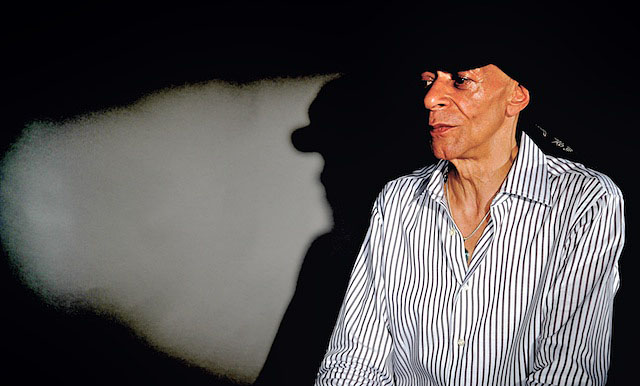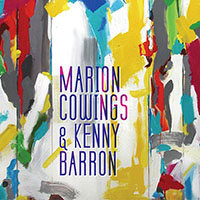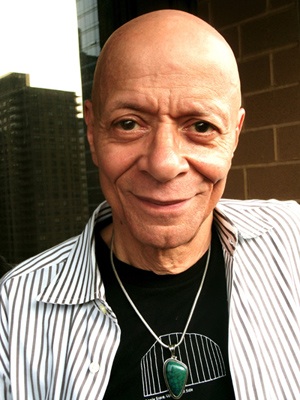Home » Jazz Articles » Catching Up With » Marion Cowings: Hey There
Marion Cowings: Hey There

All About Jazz: So Marion, I understand you have a newly released CD.
Marion Cowings Yes, I have a CD that's a reissue of a recording I made about 15 years ago with Kenny Barron. It's recently mixed, mastered and now sounds nice and clear and the fidelity is up there with everything that's nice and clear. The performance is respectable if I dare say so myself...and I dare say so myself.
AAJ: Were they live performances?
MC: Yes, let me check. Well, yes we were both alive. We went into the studio, recorded 15 songs in about three-and-a-half hours, and kept 13.
AAJ: How did you decide which songs you wanted to keep?
MC: At the time we recorded them, the studio we were in didn't have the capacity to change the pitch of a wrong note like they have now so everything had to be done as perfectly as you could the first time. When I listened to the playback and heard a bunch of lemon notes coming out from me that was enough to scratch the particular tune. Fortunately there were only two such tunes out of 15.
AAJ: What inspired you to have this collaboration with Kenny?
MC: I was ending a marriage and very emotional about it. Kenny and I had recorded three albums together before with my ex-wife, and I asked Kenny if he cared to do a duo record. I had heard [pianist] Bill Evans and [singer] Tony Bennett together, and I thought, "Mmm, if they can do it, I can do it."
That was kind of the idea of having a duet. So I called Kenny and said, "I'm feeling really heavy emotional feelings and it would be a good time to write in our musical diary. Let's do it." And he said. "Ok." So, my friend, April Lang, put up the money for the studio—and thank you April, if you're reading this—and we got to work. Kenny actually gave me his services. He said, "I can't charge you man, let's just do it." He's such a great artist and such a generous person. I can't say enough nice things about Kenny and his mastery.
I was really on my toes, 'cause I realized that I was working with the top in the field. If you were an actor it would be like having a scene with Lionel Barrymore, just the two of us, or, as a dancer, it would be just me and Baryshnikov doing a pas de deux.
So that would be the inspiration: a failed marriage and listening to Bill Evans and Tony Bennett.
 AAJ: You have an amazing musical track record, some of which was with Jon Hendricks.
AAJ: You have an amazing musical track record, some of which was with Jon Hendricks.MC: I met Jon Hendricks when I was about 15 years old. My friend, [bassist] Eddie Gomez, said, "I'm going to the Newport Jazz Festival and I'm going to see Jon and tell him about you." And he did. Then one day I got a phone call and it was Jon Hendricks and he said, "What's up? I wanna meet you at Birdland." So I met him at Birdland and I said, "I'm doing your stuff and I love it."
And that was that.
I had a little group like his, Cowings, Cummings & Lang, and at one point we all sang together with Lambert, Hendricks & Ross at the Village Vanguard. It was a pretty amazing experience. And that's how I got started singing jazz and breaking away from my generational music, which was doo-wop and such like that.
AAJ: How long were you with Lambert, Hendricks & Ross?
MC: Well, Dave Lambert left the group and I was his original replacement, but after about six months, when I was about 17, I left the group 'cause my dad wanted me to go back to school to be a doctor. I went to a conservatory instead, so it was a compromise and dad wasn't thrilled, believe me.
AAJ: Tell me about your Elvin Jones/John Coltrane story.
MC: I was 15, walking with my friend Jim Cummings up by 155th St. He was a drummer and I was a singer. We passed a station wagon with writing stenciled on the car and it read Elvin Jones. "Wow Elvin Jones! Let's wait 'til he comes out." And we stood there waiting. It didn't matter how long, cause we were in high school. We owned our own time. Time wasn't money, it was homework.
And out from the building came [saxophonist] John Coltrane, not [drummer] Elvin Jones. I said, [in a high voice] "Oh, Mr. Coltrane, I'm Marion, I'm a jazz singer, I'm a protégé of Jon Hendricks and I'm going to be in the Randall's Island Jazz Festival." [In a low voice],"You are? Oh, I'm going to be there too. I'll look for you." "That's incredible," I said. "I just want to thank you, and could I have your autograph?" I got his autograph and it says: Thank you—John Coltrane.
And, in fact, I did see him. I remember I was sitting on the side of the stage in the wings on [drummer] Gene Krupa's trap case. There was John Coltrane surrounded by reporters, like a politician on the court steps of a felony trial. John actually broke through the circle of reporters to come over to me. He said, "Wow, you're really here, you really made it." And I said [in a high voice], "Yes, I really made it." "Have a great show," he said.
And that was how I met John Coltrane. I made 25 dollars for that gig and the pay scale actually hasn't gone up since then. It's maybe 25 and a sandwich. That is, if you do a live gig for four hours.
 AAJ: What inspired you to sing and how did you get started?
AAJ: What inspired you to sing and how did you get started?MC: I was born to sing, I didn't need any inspiration. I don't know why. I could always sing, I sang for my mother when I was a little kid. My mother said [in a sweet voice], "When I was a child there was a movie that I really loved and it's going to playing on TV today, and I want you to watch it. It's The Wizard of Oz" We watched it on a little eight-inch screen, one of the first in the neighborhood in '51 and, when it was over she said, "Well what did you think? Did you like it?" And I started to sing "Somewhere Over the Rainbow."
I sang it all day, 'cause I had a musical photographic memory. She was astounded, and paid attention to me 'cause she couldn't believe what she was hearing. But I knew I could do this all the time.
AAJ: How old were you?
MC: About five or six.
Then I was in school plays, and in junior high I didn't sing; I played trombone. I entered oratory contests, which I won, cause my dad grilled me in the back of his grocery store. But then I got really lucky because a role came up for a male soloist with the New York Philharmonic with Leonard Bernstein. It was an Aaron Copland piece, which was televised and recorded. It's on Sony Masterworks. I learned a lot from that experience. I got a lot of my teaching style from Leonard Bernstein—and how to conduct, which is really required these days for singers and bandleaders.
AAJ: Wasn't [pianist] Larry Willis singing, too?
MC: Yes, he hadn't started playing piano yet.
AAJ: How is jazz different today than when you arrived on the scene?
MC: The rhythms have changed and people seem to be gravitating towards simpler forms. A lot of people put down rap, but rap musicians are really the champions of the First Amendment. They really say what's on their minds. I'm encouraged, though, by the strength and dedication of young players today and their awareness of the past. There's still gotta be a market for American standards though. More chords are going to come back.
AAJ: How do you see yourself in the future?
MC: Dead. No, really, I see myself living happily ever after in a country environment where I can take the cat, but also have a city studio and students, and jump into a plane that doesn't use gas.
AAJ: And musically?
MC: Musically, I've been thinking a lot about the blues, and the tremendous impact it has when I sing blues with the band. It's very visceral, not intellectual. It doesn't require the kind of attention span for the listener that jazz does.
AAJ: I heard your blues band and you have a very different singing persona.
MC: Yes, a different attitude. The mean side of me shows up, no more mister nice guy, Cole Porter stuff. Mister "in the closet, can't find my way out of the emotional doldrums": the blues. You can tell people what you think in just a few words with blues.
AAJ: Like?
MC: "You left me and I'm going to step on your neck," or of "If you don't come back I will step on my own neck." You can tell women more directly what you really think when you sing the blues.
AAJ: What would you say to your woman?
MC: Come back baby. Please don't go.
AAJ: I just have a few more questions for you.
MC: Yes, I sleep in the nude, No, I don't smoke.
AAJ: If you could do it all over again, would you do it all over again? Any changes?
MC: Yes; I'd have cell phone so I could have so many more gigs. Instead of going to the coin box, I would have had a career like the kids in the playground with the swing thing. "Hello; yes, I'm available to swing, goodbye." 'Cause if you don't call back right away you know they'll get the next person.
AAJ: Talk about the power of music.
MC: -There's hope, and I think music can bring people together under conditions that seem insurmountable. I've walked into hospitals, sung to mental patients and they've come out of their trance. Alzheimer's patients remember the lyrics, though they may not remember anything else. It wakes them up.
I like to "voyeur" my audience. I enjoy their pleasure. They think they're watching me, but I'm watching them enjoy the music. Someone may come up to me after the gig and comment how great the concert was, but they are only responding to the feelings, the storytelling. You see, I'm not the wine; I'm just the glass holding the wine.
Selected Discography
Marion Cowings/Kenny Barron, Marion Cowings and Kenny Barron (Redcow, 2012)
Marion Cowings, Hank and Frank II (Lineage, 2009)
Marion Cowings, If You Could See Me Now (EmArcy, 1996)
Marion Cowings, Kim and Marion (EmArcy, 1993)
Marion Cowings, Inside (Good Guise, 1984)
Leonard Bernstein/New York Philharmonic, The Second Hurricane (Sony Classic, 1960)
Photo Credits
Page 1: Courtesy of Marion Cowings
Page 2: Melanie Futorian
< Previous
Zone De Memoire
Next >
Take Five With Trevor Rabin
Comments
Tags
Marion Cowings
Catching Up With
Melanie Futorian
United States
Dave Lambert
Lambert, Hendricks & Ross
Quincy Jones
Wayne Shorter
Frank Foster
Sonny Rollins
Kenny Barron
Bill Evans
Tony Bennett
Jon Hendricks
eddie gomez
Elvin Jones
John Coltrane
Gene Krupa
Leonard Bernstein
Larry Willis
Cole Porter
For the Love of Jazz
 All About Jazz has been a pillar of jazz since 1995, championing it as an art form and, more importantly, supporting the musicians who create it. Our enduring commitment has made "AAJ" one of the most culturally important websites of its kind, read by hundreds of thousands of fans, musicians and industry figures every month.
All About Jazz has been a pillar of jazz since 1995, championing it as an art form and, more importantly, supporting the musicians who create it. Our enduring commitment has made "AAJ" one of the most culturally important websites of its kind, read by hundreds of thousands of fans, musicians and industry figures every month.























